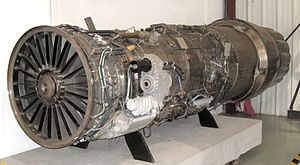
The Pratt & Whitney TF30 (company designation JTF10A) is a military low-bypass turbofan engine originally designed by Pratt & Whitney for the subsonic F6D Missileer fleet defense fighter, but this project was cancelled. It was later adapted with an afterburner for supersonic designs, and in this form it was the world's first production afterburning turbofan, going on to power the F-111 and the F-14A Tomcat, as well seeing use in early versions of the A-7 Corsair II without an afterburner. First flight of the TF30 was in 1964 and production continued until 1986.
In 1958, the Douglas Aircraft Company proposed a short-range, four-engined jet airliner to fill the gap below its new DC-8 intercontinental, known internally as the Model 2067. Intended to be marketed the DC-9, it was not directly related to the later twin-engined Douglas DC-9.
In 1960, the United States Navy selected the JT10A, designated TF30-P-1, to power the proposed Douglas F6D Missileer, but the project was canceled in April 1961. The version of the TF30 for the F-111 included an afterburner.